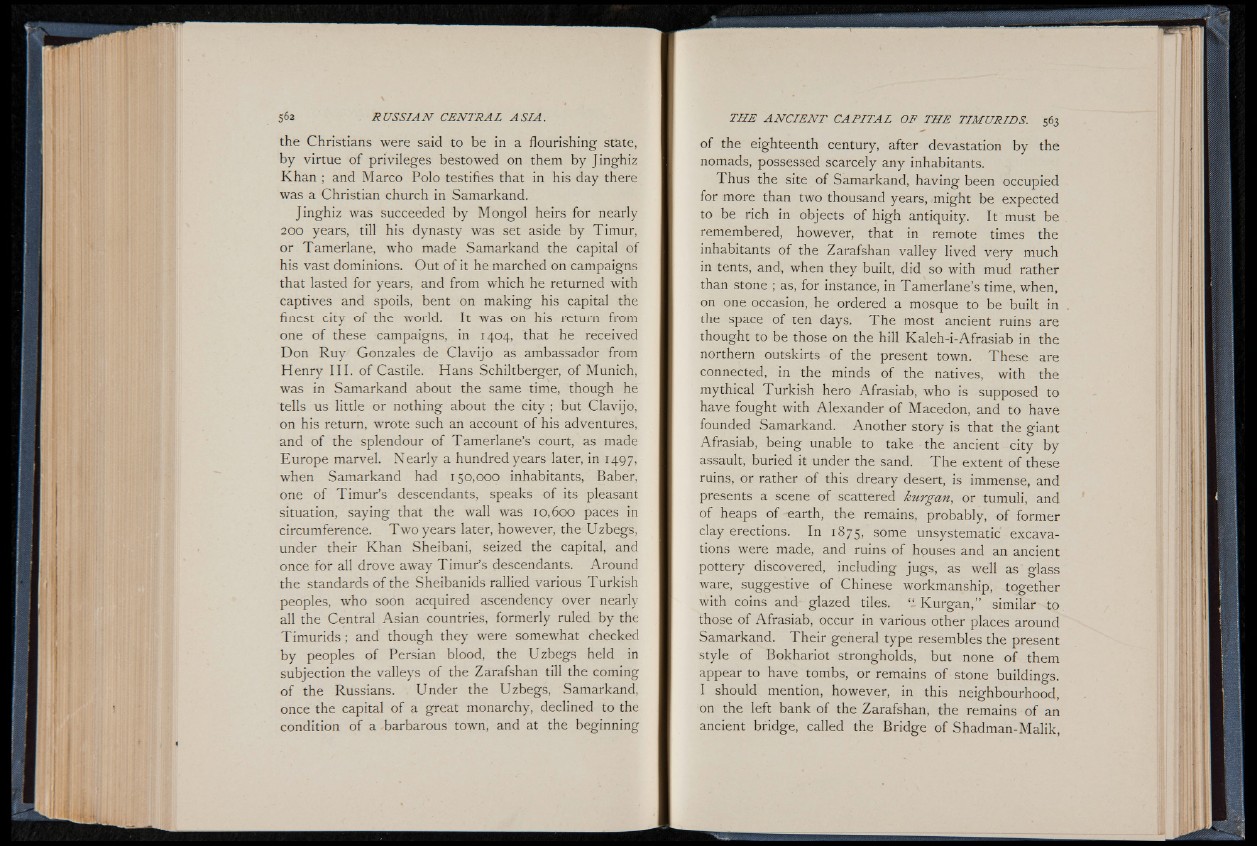
the Christians were said to be in a flourishing state,
by virtue of privileges bestowed on them by Jinghiz
Khan ; and Marco Polo testifies that in his day there
was a Christian church in Samarkand.
Jinghiz was succeeded by Mongol heirs for nearly
200 years, till his dynasty was set aside by Timur,
or Tamerlane, who made Samarkand the capital of
his vast dominions. Out of it he marched on campaigns
that lasted for years, and from which he returned with
captives and spoils, bent on making his capital the
finest city of the world. It was on his return from
one of these campaigns, in 1404, that he received
Don Ruy Gonzales de Clavijo as ambassador from
Henry III. of Castile. Hans Schiltberger, of Munich,
was in Samarkand about the same time, though he
tells us little or nothing about the city ; but Clavijo,
on his return, wrote such an account of his adventures,
and of the splendour of Tamerlane’s court, as made
Europe marvel. Nearly a hundred years later, in 1497,
when Samarkand had 150,000 inhabitants, Baber,
one of Timur’s descendants, speaks of its pleasant
situation, saying that the wall was 10,600 paces in
circumference. Two years later, however, the Uzbegs,
under their Khan Sheibani, seized the capital, and
once for all drove away Timur’s descendants. Around
the standards of the Sheibanids rallied various Turkish
peoples, who soon acquired ascendency over nearly
all the Central Asian countries, formerly ruled by the
Timurids; and though they were somewhat checked
by peoples of Persian blood, the Uzbegs held in
subjection the valleys of the Zarafshan till the coming
of the Russians. Under the Uzbegs, Samarkand,
once the capital of a great monarchy, declined to the
condition of a barbarous town, and at the beginning
of the eighteenth century, after devastation by the
nomads, possessed scarcely any inhabitants.
Thus the site of Samarkand, having been occupied
for more than two thousand years, might be expected
to be rich in objects of high antiquity. It must be
remembered, however, that in remote times the
inhabitants of the Zarafshan valley lived very much
in tents, and, when they built, did so with mud rather
than stone ; as, for instance, in Tamerlane’s time, when,
on one occasion, he ordered a mosque to be built in
the space of ten days. The most ancient ruins are
thought to be those on the hill Kaleh-i-Afrasiab in the
northern outskirts of the present town. These are
connected, in the minds of the natives, with the
mythical Turkish hero Afrasiab, who is supposed to
have fought with Alexander of Macedon, and to have
founded Samarkand. Another story is that the giant
Afrasiab, being unable to take the ancient city by
assault, buried it under the sand. The extent of these
ruins, or rather of this dreary desert, is immense, and
presents a scene of scattered kurgan, or tumuli, and
of heaps of -earth, the remains, probably, of former
clay erections. In 1875, some unsystematic excavations
were made, and ruins of houses and an ancient
pottery discovered, including jugs, as well as glass
ware, suggestive of Chinese workmanship, together
with coins and glazed tiles. iS Kurgan,” similar to
those of Afrasiab, occur in various other places around
Samarkand. Their general type resembles the present
style of Bokhariot strongholds, but none of them
appear to have tombs, or remains of stone buildings.
I should mention, however, in this neighbourhood,
on the left bank of the Zarafshan, the remains of an
ancient bridge, called the Bridge of Shadman-Malik,